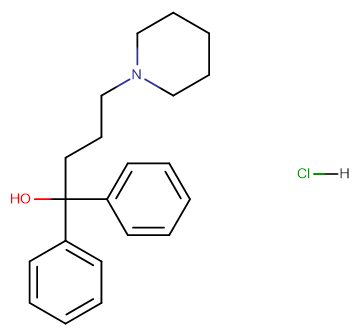
Diphenidol hydrochloride
CAS No. 3254-89-5
Diphenidol hydrochloride ( SKF 478A )
Catalog No. M14054 CAS No. 3254-89-5
Diphenidol hydrochloride is a muscarinic antagonist employed as an antiemetic and as an antivertigo agent.
Purity : >98%(HPLC)
 COA
COA
 Datasheet
Datasheet
 HNMR
HNMR
 HPLC
HPLC
 MSDS
MSDS
 Handing Instructions
Handing Instructions
| Size | Price / USD | Stock | Quantity |
| 100MG | 42 | In Stock |


|
| 200MG | 61 | In Stock |


|
| 500MG | 101 | In Stock |


|
| 1G | Get Quote | In Stock |


|
Biological Information
-
Product NameDiphenidol hydrochloride
-
NoteResearch use only, not for human use.
-
Brief DescriptionDiphenidol hydrochloride is a muscarinic antagonist employed as an antiemetic and as an antivertigo agent.
-
DescriptionDiphenidol hydrochloride is a muscarinic antagonist employed as an antiemetic and as an antivertigo agent.
-
SynonymsSKF 478A
-
PathwayEndocrinology/Hormones
-
TargetAChR
-
RecptormAChR
-
Research AreaNeurological Disease
-
Indication——
Chemical Information
-
CAS Number3254-89-5
-
Formula Weight345.91
-
Molecular FormulaC21H28ClNO
-
Purity>98%(HPLC)
-
SolubilityEthanol: 36 mg/mL warmed (104.07 mM); Water: 13 mg/mL (37.58 mM); DMSO: 69 mg/mL (199.47 mM)
-
SMILESOC(C1=CC=CC=C1)(C2=CC=CC=C2)CCCN3CCCCC3.[H]Cl
-
Chemical Name1,1-Diphenyl-4-piperidin-1-ylbutan-1-ol hydrochloride
Shipping & Storage Information
-
Storage(-20℃)
-
ShippingWith Ice Pack
-
Stability≥ 2 years
Reference
1.Leung YM, et al. Pharmacol Rep. 2012;64(3):739-44.
molnova catalog


related products
-
6-Ethoxydihydrosangu...
6-Ethoxydihydrosanguinarine shows human blood acetylcholinesterase (HuAChE) and human plasma butyrylcholinesterase (HuBuChE) inhibitory activity, with IC50 values of 0.83 +/- 0.04 microM and 4.20 +/- 0.19 microM, respectively.
-
BMS-303141
BMS-303141 is a potent ATP-citrate lyase (ACL) inhibitor (IC50: 0.13 uM, human recombinant ACL).
-
Scopolamine HBr
Scopolamine hydrobromide is a competitive muscarinic acetylcholine receptor (mAChR) with an IC50 of 55.3 ± 4.3 nM.



 Cart
Cart
 sales@molnova.com
sales@molnova.com


